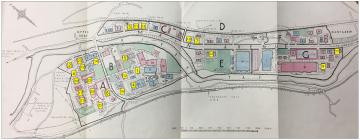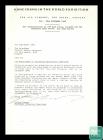Gellir lawrlwytho cynnwys at ddefnydd anfasnachol, megis defnydd personol neu ar gyfer adnoddau addysgol.
Ar gyfer defnydd masnachol cysyllwch yn uniongyrchol gyda deilydd yr hawlfraint os gwelwch yn dda.
Read more about the The Creative Archive Licence.
Disgrifiad
Correspondence from Hoggett Lock-Necrews Chartered Architects and Planning Consultants, and D. Foley, Comprehensive Builder, to Penylan House:
The first item (images 1 and 2) is a letter from Hoggett Lock-Necrews Chartered Architects and Planning Consultants, to Penylan House Management. The letter is dated 14 March 1988 and is signed by Clive Hill. Hill states that he visited Penylan House on 10 March 1988 and he was writing to confirm the outcome of his investigations. He states that from looking at the walls, the moisture inside them was not too problematic and could "be lived with". He notes that poor initial construction had caused the lintels to rotate both externally and inwardly, causing the breakdown of their joints with the external brick, which could not be fixed without "enormous cost". Hill then recommends three courses of action to prevent further movement of the external skin of the building, such as cutting weep holes above windows to allow ventilation of the cavity space. Hill ends by stating that specialist Contractors for the job should not be necessary and could be carried out by a bricklayer with hired equipment.
The following page (image 3) is dated 23 May 1988, and is from D. Foley, Comprehensive Builder, to Penylan House. It states that the letter is following a meeting attended by architect, Mr Clive Hill of Hoggett Lock-Necrews Chartered Architects and Planning Consultants, Penylan House management and himself on 28 April 1988 to "discuss the structural movements in the property". Foley then lists the tree proposed actions and estimates how much this would cost, emphasising how specialist equipment would need to be hired and this would not be cheap. Overall, the total cost for three weeks' work, including VAT would be £5436.05. The letter ends by stating "If the above terms are acceptable, please confirm in writing".
The final page (image 4) is an Estimate, also from D. Foley and is dated 11 October 1988. It states the cost of the building works to be carried out at Penylan House, estimating this would take around four weeks. The cost of the work and the "blades" is stated, adding up to a total cost of £7171.40, with VAT included. Written at the bottom of the page in pen are the words: "13 Oct 88 - Paid in full" and is signed D. Foley. This sheet appears to be a photocopy.
Pencare (formerly known as 'The Trustees of Penylan House') is a charity, which offers care for elderly people of the Jewish faith and is currently based in Cardiff, although the catchment area for the home covers South Wales and the West of England. Pencare has been working with Linc Cymru to redevelop their care home, Penylan House, to ensure high quality care to Cardiff's elderly Jewish community and extending the care to elderly people not of the Jewish faith.
Mr Henry Silver and other members of the Cardiff Jewish community had originally founded a Home for the Aged in 1946 in Canton. In December 1948, the Home moved to Holme Towers in Penarth to provide more space for its large number of applications. Despite the beautiful surroundings, the Home in Penarth was quite isolated, so the difficult decision was later taken to move the Home to Penylan Road in Cardiff, meaning many residents were now closer to their friends and relatives. Residents moved to Penylan House in February 1959.
Sources:
http://opencharities.org/charities/243968;
http://www.housingcare.org/downloads/facilities/generated-brochures/134508-penylan-house-nursing-home-cardiff-wales.pdf;
Cajex, Magazine of the Association of Jewish Ex-service Men and Women (Cardiff), Vol. IX, No. 1, Ninth Year - March 1959, pp. 60- 65.
Depository: Glamorgan Archives.












Oes gennych chi wybodaeth ychwanegol am yr eitem hon? Gadewch sylwad isod
Sylwadau (0)
Rhaid mewngofnodi i bostio sylw